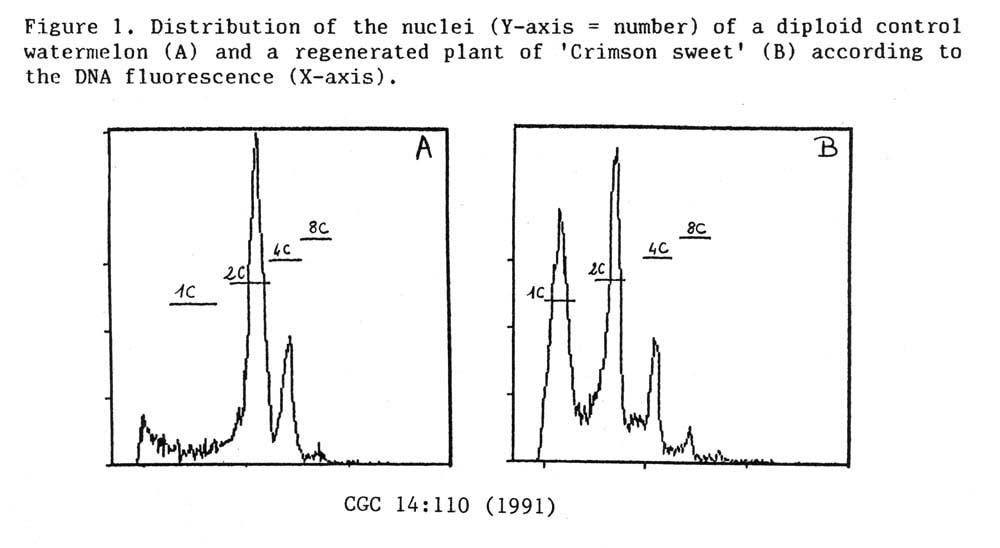Cucurbit Genetics Cooperative Report 14:109-110 (article 38) 1991
N. Gursoz, K. Abak, M. Pitrat, J.C. Rode andR. Dumas de Vaulx
Cukurova University, Faculty of Agriculture, Dept. of Horticulture, Adana (Turkey), Station d’Amelioration des Plantes Maraicheres, I.N.R.A., BP 94,84143 Montfavet Cedex (France)
The first haploid plant in Cucurbitaceae was observed spontaneously in cucumber in 1958 (1). The first induced haploid was obtained in muskmelon by pollination of Cucumis melo with C. ficifolius pollen (3). However, the use of haploidy in breeding programs was actually possible only after discovering the induction of gynogenesis in situ with gamma rays irradiated pollen of C. melo followed by rescue of haploid embryos by in vitro culture (4). And then this technic was also applied to cucumber (2).
Until now, in the literature, two studies of haploidy in watermelon have been reported. In 1958, one haploid branch was observed on a watermelon plant irradiated by X-ray (5). In 1983, it was reported that some haploid tissue as well as haploid plantlets were obtained by anther culture, but they did not develop into complete plants (6).
Here we report the obtention of haploid watermelon plants by gynogenesis induced by gamma rays irradiated pollen (300 Gy) with the method proposed by Sauton (4) on muskmelon.
The plant material consists of a F1 hybrid ‘Panonia’ and three open pollinated cv ‘Crimson sweet’., ‘Sugar baby’ and ‘Halep Karasi’. In order to find an effect of the season and the genotypes on haploid embryo production, seeds were sown for 7 times with 15 days intervals from 5th January to 6th April, 19990. According to the results, haploid embryo formation was influenced by genotypes and sowing and polliination periods.
Embryos obtained were at different development stages: 72% globular, 28% heart shaped (8% soft, 19% necrotic and 1% normal heart shaped). A total number of 761 embryos were obtained from 13,884 seeds and only 17 embryos regenerated into plants. One from ‘Crimson sweet’, 5 from ‘Halep Karasi’, 5 from ‘Sugar baby’ and 6 from ‘Panonia’., The percentage of plant regeneration (2.2%) is very low probably because most of the embryos were in the globular stage and most of the heart shaped were soft or necrotic. Only 5 normal heart shaped embryos were observed. They were obtained from the last pollination period (May 31 to June 13). This indicated that, in order to increase the success of the method, the pollination period must be during the period where the plant growth is better.
The DNA content has been estimated by the fluorescence of propidium iodure (analysis made by B. Longhi and J. Roustan, I.M.I.M., Montpellier, France). The regenerated plants have between 33 and 46% of their cells which were haploid compared with 0% in the diploid control (Table 1 and Figure 1). There is a tendency to natural doubling with around 10% of the nuclei at the 4C level and even some 8C.
Table 1. frequency of leaf cells with different DNA content in regnerated watermelon plants.
Plant |
Conditions* |
1C |
2C |
4C |
8C |
| Crimson sweet | A | 33.5 | 39.5 | 11.5 | 2.5 |
| Crimson sweet | B | 35.5 | 35.5 | 11.5 | 2.5 |
| Halep Karsi | A | 42.5 | 27.5 | 7.5 | 2 |
| Sugar baby | B | 46.5 | 30 | 9.5 | 1.5 |
| Diploid control | C | 0 | 59.5 | 19 | 2 |
*A = Cuttings transplanted in pots in the greenhouse; = in vitro cuttings; C = Plants from seeds in the greenhouse.
Figure 1. Distribution of the nuclei (Y-axis = number ) of a diploid control watermelon (A) and a regenerated plant of ‘Crimson sweet’ (B) according to the DNA fluorescence (X-axis).

Literature Cited
- Aalders, L.E. 1958. Monoploidy in cucumbers. J. Hered. 49:41-44.
- Andre, I. 1988. In vitro haploid plants derived from pollination by irradiated pollen on cucumber. Proc. EUCARPIA Meeting “Cucurbitaceae 88”. 05.31-06/02/1988, Avignon (France), 143-144.
- Dumas, de Vaulx R. 1979. Obtention de plantes haploides chez le melon Cucumis melo L.) apres pollinisation par Cucumis ficifolius A. Rich. C.R. Acad. Sci., Paris, 875-878.
- Sauton, A. 1987. Recherche d’haploides chez le melon (Cucumis melo L.). Etude et application a la selection de la parthenogenese induite par du pollen irradie. Ph. Thesis, Montpellier, 123pp.
- Swaminathan, M.S., and M.P. Singh. 1958. X-ray induced somatic haploidy in watermelon. Curr. Sci. 27:63-64.
- Xue, G.R., W.Y. Yu, and K.W. Fei. 1983. Watermelon plants derived by in vitro anther culture. Plant Physiol. commun. 4:40-42.